Accepted Scientific Name: Echinocereus viridiflorus subs. davisii (Houghton) N.P.Taylor
Cactaceae Consensus Init. 3: 10. 1997
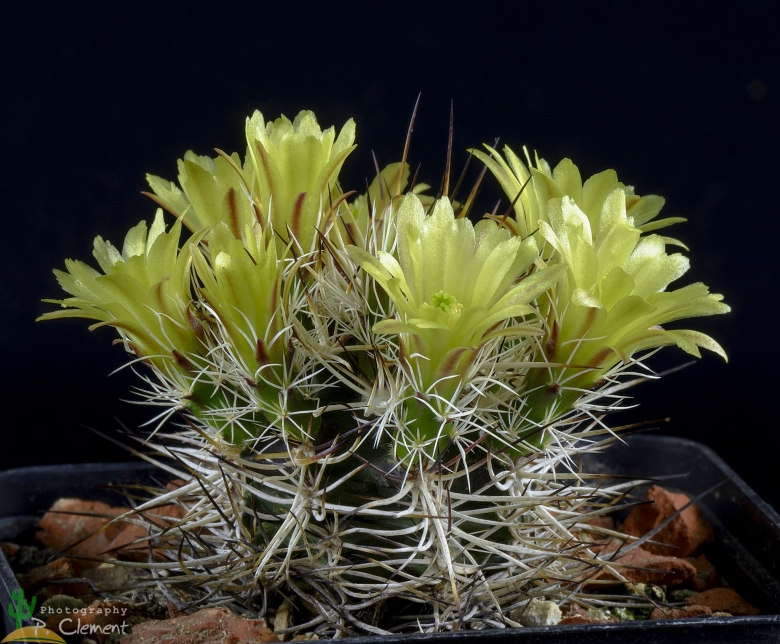
Echinocereus viridiflorus var. davisii (Echinocereus viridiflorus subs. davisii) Photo by: Peiffer Clement
This species blooms very early in March. The flowers are greenish and diffuse a pleasant lemony scent.
Origin and Habitat: The single known population occurs Marathon, Brewster County in Trans-Pecos, in west Texas.
Altitude: Around 1200 metres above sea level.
Habitat: It grows in flat hills on a specific substrate (rich in quartz sand) in a semi-desert grassland among sparse desert scrub, usually hidden in mats of Selaginella peruviana, but also among rocks and under shrubs. Sometimes plants in drought periods shrink well below ground level. Associates cactus species include include Echinocereus viridiflorusSN|7817]]SN|11071]] var. corellii, Thelocactus bicolorSN|3420]]SN|3420]] var. flavidispinus, Escobaria hesteriSN|10308]]SN|10222]], Escobaria minimaSN|10222]]SN|10308]], Opuntia rnacrocentra, Echinocereus stramineusSN|11071]]SN|7817]], and Mammillaria heyderiSN|20805]]SN|20805]]. In the same area it is also possible to find a spare shrubby and herbaceous vegetation comprising: Viguiera stenoloha, Acacia constricta, Bouteloua ramosa, Dasyochloa pulchella, Larrea tridentata, Agave lechuguillaSN|23013]]SN|23013]], Yucca elata, Yucca torreyi, Dasylirion leiophyllum, Nolina texana, Zinnia acerosa, and Thymophylla pentachaeta.
Synonyms:
See all synonyms of Echinocereus viridiflorus
Description: Echinocereus viridiflorus var. davisii is the tiniest Echinocereus species, and one of the smallest cacti in the world, plants are extremely diminutive and mostly subterranean (geophytes), usually do not offset. The diminutive size and the reduced number of ribs (6-10) distinguish E. viridiflorus v. davisii from all other species of the Echinocereus viridiflorusSN|11085]]SN|11071]] complex. Moreover it has no wool on the ovary areoles while the other does.
Habit: Usually solitary, but branched plants are found occasionally.
Roots: Fibrous in young plant became tuberous in age.
Stem: Spherical to ovoid or top-shaped, with a large underground portion merging with the swollen rootstock, dark green epidermis up to 1-2(-3,5) cm in high and 0,8-2,5(-3) cm in diameter, but cultivated specimens can grow bigger (up to 8 cm tall and 6 cm in diameter) and stems eventually branch into compact clumps. E. viridiflorus var. davisii are not short lived, but when they reach the mature flowering size, they continue to produce new areoles and bloom for decades, but hardly increase in size.
Ribs: 6-10 divided in prominently raised tubercles 2-2,5 mm tall.
Areoles: Narrow oval to elongated 3-4,5 mm long, with scarce wool, even when young.
Spines: Partially or mostly obscuring the stem, needle-like, usually all radial, but mature specimens may occasionally produce a single reddish-purple central spine 1-1,2 mm long.
Radial spines: 8-14 more or less pectinate, white with the outer one-half of a contrasting black or reddish-purple colour, turning to grey or white with reddish or dark brown tips, upper ones slender, round, 4-7 mm long, lateral ones stouter, usually flattened, 11-19 mm long, straight or somewhat curved or recurved against stem. Young seedling have tiny, feathery, pectinated spines which are flattened against the stem and white.
Flower: Funnel-shaped, campanulate or occasionally rotate, usually not opening widely, yellow-green or straw-yellow, weakly lemon-scented 1,5-2,5 cm long, 1,5-2,7 cm across, often larger than stems, (buds acute, reddish and yellow-greenish). Ovary and floral tube slender with 10-14 areoles bearing short plumose spines and not woolly. Inner perianth segments straw-yellow or greenish-yellow, linear to slightly broadened above, pointed, bluntly rounded or emarginate. Outer perianth segments narrow, pointed and entire, with midlines reddish or umber and the margins yellow. Stile pale green up to 1,4 cm long, exerted above the anther, with 5-7 green heavy stigma lobes. Filaments pale green 5-9 mm long, pollen light yellow. They are self-incompatible.
Blooming season: Blossoming and fruiting occur on 3 to 4 year-old plants. Blooming period in cultivation is March-April and the flowering period usually lasts 10-20 days (but this period must be expanded under favorable growing conditions. The flowers open in the morning till afternoon and again for 3-4 days after closing at night.
Fruits: Green with reddish tinge or purplish-brown, dry, oval, 5-11 mm long, 4-5(-8) mm in diameter. At maturity the fruit splits open vertically and soon dry out. The spiny areoles are deciduous. Each usually seed contains less than 40 seeds.
Seeds: Black, warty, 0,9-1,1 mm long, 0,8-0,9 mm wide.
*Chromosome number: 2n = 22
N.B.: Echinocereus viridiflorusSN|11085]]SN|11071]] in the broad sense may prove paraphyletic with respect to Echinocereus davisiiSN|11085]]SN|11085]], but they are phenologically isolated, with Echinocereus davisiiSN|11071]]SN|11085]] flowering earlier and thus appearing reproductively isolated in the wild. Controversy among botanists as to whether Echinocereus davisiiSN|11071]]SN|11085]] is a species or variety of Echinocereus viridiflorus.
Subspecies, varieties, forms and cultivars of plants belonging to the Echinocereus viridiflorus/russanthus complex
 Echinocereus carmenensis W.Blum, Mich.Lange & E.Scherer in W.Blum et al.: has stocky body covered by tight yellowish pectinate spines and peculiar chocolate-scented flowers. Distribution: La Cuesta, passo Sierra del Carmem, Coahuila, Mexico.
Echinocereus carmenensis W.Blum, Mich.Lange & E.Scherer in W.Blum et al.: has stocky body covered by tight yellowish pectinate spines and peculiar chocolate-scented flowers. Distribution: La Cuesta, passo Sierra del Carmem, Coahuila, Mexico. Echinocereus milleri W.Blum, Kuenzler & Oldach: has the "hairy" seedlings of Echinocereus viridiflorus var. neocapillus, but has fewer spines it is also similar to the yellow spined Echinocereus viridiflorus subs. Correllii (which it obviously is not).
Echinocereus milleri W.Blum, Kuenzler & Oldach: has the "hairy" seedlings of Echinocereus viridiflorus var. neocapillus, but has fewer spines it is also similar to the yellow spined Echinocereus viridiflorus subs. Correllii (which it obviously is not). Echinocereus russanthus D.Weniger: has spheric to cylindrical stems, 8-30 tall and 4-8 cm Ø; ribs 10-20. Spines: Interlocking, bristly, typically reddish to brown, radiating in all directions. Distribution: Chihuahua (Mexico) and N-W Texas (USA).
Echinocereus russanthus D.Weniger: has spheric to cylindrical stems, 8-30 tall and 4-8 cm Ø; ribs 10-20. Spines: Interlocking, bristly, typically reddish to brown, radiating in all directions. Distribution: Chihuahua (Mexico) and N-W Texas (USA). Echinocereus russanthus f. cristata hort.: crested form.
Echinocereus russanthus f. cristata hort.: crested form. Echinocereus russanthus subs. fiehnii (Trocha) W.Blum & Mich.Lange: Distribution: endemic to the Sierra del Nido, central Chihuahua, Mexico.
Echinocereus russanthus subs. fiehnii (Trocha) W.Blum & Mich.Lange: Distribution: endemic to the Sierra del Nido, central Chihuahua, Mexico.- Echinocereus russanthus subs. weedinii Leuck ex W.Blum & Mich.Lange in W.Blum et al.
 Echinocereus viridiflorus Engelm. in Wisliz.: ssp. viridiflorus (Typical form) With small stems and relatively pure yellow flowers, extends from central New Mexico and the Texas Panhandle to South Dakota.
Echinocereus viridiflorus Engelm. in Wisliz.: ssp. viridiflorus (Typical form) With small stems and relatively pure yellow flowers, extends from central New Mexico and the Texas Panhandle to South Dakota. Echinocereus viridiflorus var. canus A.M.Powell & Weedin: has hairy juvenile forms. Distribution: Solitario, Sandstone ridge above Righthand Shutup, Presidio Co., Texas, USA.
Echinocereus viridiflorus var. canus A.M.Powell & Weedin: has hairy juvenile forms. Distribution: Solitario, Sandstone ridge above Righthand Shutup, Presidio Co., Texas, USA. Echinocereus viridiflorus subs. chloranthus (Engelm.) N.P.Taylor: has 10-18 ribs, 5 or more central spines, giving the plants a bristly appearance, it is often considered a separate species (Echinocereus chloranthus). Distribution: W. Texas, S.E. New Mexico, and N. Mexico.
Echinocereus viridiflorus subs. chloranthus (Engelm.) N.P.Taylor: has 10-18 ribs, 5 or more central spines, giving the plants a bristly appearance, it is often considered a separate species (Echinocereus chloranthus). Distribution: W. Texas, S.E. New Mexico, and N. Mexico. Echinocereus viridiflorus subs. correllii (L.D.Benson) W.Blum & Mich.Lange in W.Blum et al.: It is a poorly defined, yellow-spined population near Marathon, Texas.
Echinocereus viridiflorus subs. correllii (L.D.Benson) W.Blum & Mich.Lange in W.Blum et al.: It is a poorly defined, yellow-spined population near Marathon, Texas. Echinocereus viridiflorus cowperii n.n.: same as: Echinocereus viridiflorus var. rhyolithensis.
Echinocereus viridiflorus cowperii n.n.: same as: Echinocereus viridiflorus var. rhyolithensis. Echinocereus viridiflorus subs. cylindricus (Engelm.) N.P.Taylor: The common morphotype grows at middle altitudes in Texas and southeastern New Mexico, it has 0-2(-3) central spines.
Echinocereus viridiflorus subs. cylindricus (Engelm.) N.P.Taylor: The common morphotype grows at middle altitudes in Texas and southeastern New Mexico, it has 0-2(-3) central spines. Echinocereus viridiflorus subs. davisii (Houghton) N.P.Taylor: In the broad sense Echinocereus viridiflorus may prove paraphyletic with respect to Echinocereus davisii, but they are phenologically isolated, with Echinocereus davisii flowering earlier and thus appearing reproductively isolated in the wild.
Echinocereus viridiflorus subs. davisii (Houghton) N.P.Taylor: In the broad sense Echinocereus viridiflorus may prove paraphyletic with respect to Echinocereus davisii, but they are phenologically isolated, with Echinocereus davisii flowering earlier and thus appearing reproductively isolated in the wild. Echinocereus viridiflorus subs. davisii cv. brevispinus hort.: has very short spines, usually radial, pectinated, stout, fang like, white whit a dark contrasting tip 2-4 mm long. Spine clusters looks like small starfishes.
Echinocereus viridiflorus subs. davisii cv. brevispinus hort.: has very short spines, usually radial, pectinated, stout, fang like, white whit a dark contrasting tip 2-4 mm long. Spine clusters looks like small starfishes. Echinocereus viridiflorus var. montanus hort.: has significantly depressed stems solitary or in low clusters (mostly less than 2 cm tall). Distribution: Southwestern USA (Monarch Pass, Colorado?)
Echinocereus viridiflorus var. montanus hort.: has significantly depressed stems solitary or in low clusters (mostly less than 2 cm tall). Distribution: Southwestern USA (Monarch Pass, Colorado?) Echinocereus viridiflorus var. neocapillus (D.Weniger) A.D.Zimmerman: Remarkable for its softly hairy, not sharply spiny, seedlings.
Echinocereus viridiflorus var. neocapillus (D.Weniger) A.D.Zimmerman: Remarkable for its softly hairy, not sharply spiny, seedlings.- Echinocereus viridiflorus var. rhyolithensis W. Blume & Mich.Lange: (Echinocereus russantus forma) Bristly red-spined plants from New Mexico.
 Echinocereus viridiflorus var. robustior Kuenzler: It is a more robust form but not sufficiently differentiated and considered merely a local variant of Echinocereus viridiflorus var viridiflorus. Distribution New Mexico.
Echinocereus viridiflorus var. robustior Kuenzler: It is a more robust form but not sufficiently differentiated and considered merely a local variant of Echinocereus viridiflorus var viridiflorus. Distribution New Mexico.
Notes: Echinocereus viridiflorusSN|11071]]SN|11071]] var. davisii along with Escobaria minimaSN|10308]]SN|10308]]is one of the two dwarf cacti of Brewster County growing on the same few hills, both of them growing underneath the Selaginella in the crevices of rocky ledges.
Bibliography: Major references and further lectures
1) Edward Anderson “The Cactus family” Timber Press, Incorporated, 2001
2) James Cullen, Sabina G. Knees, H. Suzanne Cubey "The European Garden Flora Flowering Plants: A Manual for the Identification of Plants Cultivated in Europe, Both Out-of-Doors and Under Glass" Cambridge University Press, 11/Aug/2011
3) David R Hunt; Nigel P Taylor; Graham Charles; International Cactaceae Systematics Group. "The New Cactus Lexicon" dh books, 2006
4) Brian Loflin, Shirley Loflin “Texas Cacti: A Field Guide” Texas A&M University Press, 26/ott/2009
5) Albert Michael Powell, James F. Weedin “Cacti of the Trans-Pecos and Adjacent Areas” Texas Tech University Press, 2004
6) Del Weniger “Cacti of the Southwest: Texas, New Mexico, Oklahoma, Arkansas, and Louisiana” University of Texas Press, 1969
7) Jackie M. Poole, William R. Sarr, Dana M. Price,& Jason R. Singhurst, “Rare Plants of Texas: A Field Guide” Texas A&M University Press, 2007
 Echinocereus davisii SB 426 Locality: Brewster County, Texas, USA. (Echinocereus viridiflorus subs. davisii) Photo by: Valentino Vallicelli
Echinocereus davisii SB 426 Locality: Brewster County, Texas, USA. (Echinocereus viridiflorus subs. davisii) Photo by: Valentino Vallicelli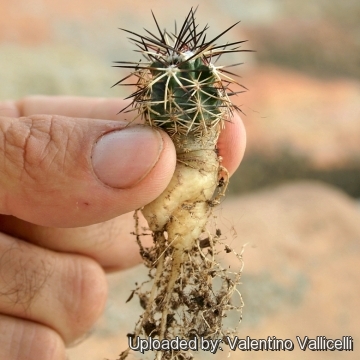 A seven years old specimen. (Echinocereus viridiflorus subs. davisii) Photo by: Valentino Vallicelli
A seven years old specimen. (Echinocereus viridiflorus subs. davisii) Photo by: Valentino Vallicelli It starts flowering when less than 1 cm in diameter (Echinocereus viridiflorus subs. davisii) Photo by: Valentino Vallicelli
It starts flowering when less than 1 cm in diameter (Echinocereus viridiflorus subs. davisii) Photo by: Valentino Vallicelli New spines, (Echinocereus viridiflorus subs. davisii) Photo by: Valentino Vallicelli
New spines, (Echinocereus viridiflorus subs. davisii) Photo by: Valentino Vallicelli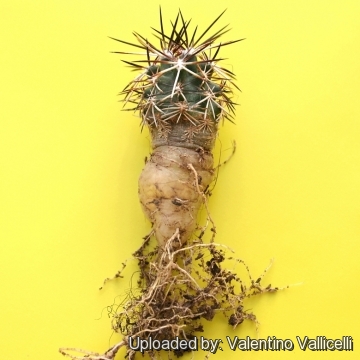 It is the tiniest of all the echinocereus. (Echinocereus viridiflorus subs. davisii) Photo by: Valentino Vallicelli
It is the tiniest of all the echinocereus. (Echinocereus viridiflorus subs. davisii) Photo by: Valentino Vallicelli Echinocereus viridiflorus var. davisii (Echinocereus viridiflorus subs. davisii) Photo by: Valentino Vallicelli
Echinocereus viridiflorus var. davisii (Echinocereus viridiflorus subs. davisii) Photo by: Valentino Vallicelli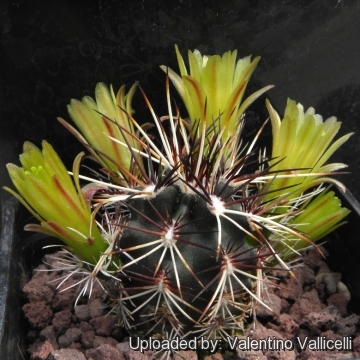 Echinocereus viridiflorus var. davisii (Echinocereus viridiflorus subs. davisii) Photo by: Valentino Vallicelli
Echinocereus viridiflorus var. davisii (Echinocereus viridiflorus subs. davisii) Photo by: Valentino Vallicelli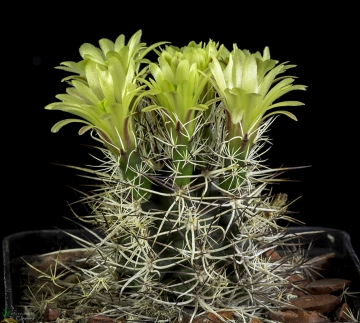 Echinocereus viridiflorus var. davisii (Echinocereus viridiflorus subs. davisii) Photo by: Peiffer Clement
Echinocereus viridiflorus var. davisii (Echinocereus viridiflorus subs. davisii) Photo by: Peiffer ClementCultivation and Propagation: In culture it is without problems and regularly shows its small greenish flowers if we provide an adequate winter rest period. They are re small plants with scented flowers that are better close to nose level. Displaying your cacti on shelves has the added benefit of keeping them off the ground and away from potential rodent or snail damage.
Soil: Use mineral well-permeable substratum with little organic matter (peat, humus).
Repotting: Repotting every 2-3 years. It will need a pot with sufficient depth to allow the tap root. As it is especially prone to rot under-pot in a smaller container filled with very porous compost. Use pot with good drainage.
Watering: Water sparingly from March till October, and keep perfectly dry in winter, at temperatures from 5 to 15 degrees centigrade. In the rest period no high atmospheric humidity!!Care must be taken with watering as they tends to become swollen and untidy in growth habit if given too much water and shade.
Exposition: Outside bright sun, filtered sunlight or afternoon shade, inside it needs bright light, and some direct sun. Subject to sunburn if exposed to direct sun for too long. Tends to bronze in strong light, which encourages flowering and heavy spine production.
Hardiness: Keep drier and cool in winter. Very cold resistant hardy to -10° C or less for short periods of time.
Fertilization: During the growing season enrich the soil using a fertilizer rich in potassium and phosphorous, but poor in nitrogen, because this chemical element doesn’t help the development of succulent plants, making them too soft and full of water.
Pests & diseases: It may be attractive to a variety of insects, but plants in good condition should be nearly pest-free, particularly if they are grown in a mineral potting-mix, with good exposure and ventilation. Nonetheless, there are several pests to watch for:
- Red spiders: Sensitive to red spider mite. Overhead watering is helpful in controlling mites.
- Mealy bugs: Occasionally mealy bugs they develop aerial into the new growth among the wool with disfiguring results, but the worst types develop underground on the roots and are invisible except by their effects.
- Scales: Scales are rarely a problem.
- Rot: Rot it is only a minor problem with cacti if the plants are watered and “aired” correctly. If they are not, fungicides won't help all that much.
Propagation: Seeds or cutting (if available). Seeds germinate in 7-14 days at 21-27° C in spring, remove the glass cover gradually as the plants develops and keep ventilated, no full sun for young plants! The seedlings should not be disturbed until they are well rooted, after which they can be planted separately in small pots.
Your Photos

by Valentino Vallicelli




















